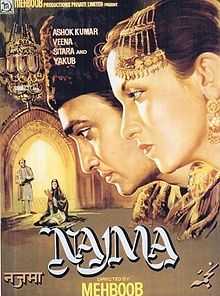Muslim social
The Muslim social is a film genre in Hindi cinema that portrays and critiques Islamic culture in India. It flourished in the 1950s and 60s and lasted till early 1980s. Muslim socials are divided into two categories: "classic Muslim socials" that explore nawabi culture and focus on upper class or elite Muslim families, and "new wave Muslim socials" that portray middle class Muslim families who experience economic problems, discrimination and communal violence.[1] Muslim socials often include ghazals, qawwalis, Urdu poetry and expressions, and musical forms commonly associated with Islamic culture.[2]
History

The earliest Muslim socials were made in the 1930s after the advent of sound and continued to be popular until the 1980s. The genre's popularity was partly due to the financial success of Mehboob Khan's Najma (1943), which became the blueprint for Muslim socials that followed, which too delved on social issues around Muslim families, no matter what the setting, giving the genre its title.[3][4]
Based on the life of Mughal Emperor, Jahangir, Pukar (1939) made by Sohrab Modi, known for his historicals, is the first notable film in this genre.[5] Soon Hindi cinema based in Mumbai became the hub for Muslim socials, and it employed a large number of Muslim producers, director, screenwriters, music directors, lyricists and actors,[5] most notably Mehboob Khan, K. A. Abbas, Kamal Amrohi, Abrar Alvi, Saadat Hassan Manto, Ismat Chugtai, Ghulam Haider, Khayyam, Sahir Ludhianvi, Majrooh Sultanpuri, Shakeel Badayuni, Mohammed Rafi, Talat Mahmood, Shamshad Begum.[6] Numerous films were made about the Mughals, including Humayun (1945) by Mehboob Khan, Taj Mahal (1963) by M. Sadiq, and Jahan Ara (1964), however the pinnacle of this royalty theme was Mughal-e-Azam (1960) by K. Asif, about Akbar, his son Prince Salim (later known as Jahangir), and the courtesan Anarkali, who itself became the theme of other films, like Anarkali (1953).[5] Another popular theme of the period was centered on the nawabi culture, especially the culture of Awadh, present day Lucknow, it produced films marked by elaborate production, music and highlighting the sophistication of language and lifestyle, like Mirza Ghalib (1954), Chaudhvin Ka Chand (1960), Mere Mehboob (1963), Dil Hi To Hai (1963) and Pakeezah (1972) by Kamal Amrohi, starring Meena Kumari, which spent over a decade in making.[6][7]
Thereafter the films in this genre shifted from regal that of fading Nawabi culture - Bahu Begum (1967). After experiencing its height in the 1970s, the genre descended to being a mere stereotypical and kitschy representation complete a kotha of a courtesan or a nawab stricken with poverty. One exception was Umrao Jaan (1981) directed by Muzaffar Ali based on 1905 historical novel Umrao Jaan Ada by Mirza Hadi Ruswa.
More over reflecting on the changing times, themes shifted regal to middle class North Indian Muslims, and from mainstream Bollywood to parallel cinema or the new wave cinema, starting with Dastak (1970), Garm Hava (1973), Bazaar (1982) and Nikaah (1982). Besides that Ali made Anjuman (1989), and Saeed Akhtar Mirza made Salim Langde Pe Mat Ro (1989) and Naseem (1995). Gradually the genre lost both nuanced depiction of its hey days was imitated by the cinema many Muslim countries, and audiences as well, and few notable additions were made to this genre, and too sporadic.[4][5][7]
The genre resurfaced in works of the screenwriter Khalid Mohammed, Mammo (1994), Sardari Begum (1996), Fiza (2000) and Zubeidaa (2001), Mohammed directed Fiza, while the rest were directed by art film master Shyam Benegal, Benegal had previously directed, and Junoon (1978) set in the Indian Rebellion of 1857, stories with marked political content.[6]
Classic Muslim socials
- Pukar (1939)
- Qaidi (1940)
- Najma (1943)
- Elaan (1947)
- Chaudhvin Ka Chand (1960)
- Mere Mehboob (1963)
- Benazir (1964)
- Gazal (1964)
- Palki (1967)
- Bahu Begum (1967)
- Mere Huzoor (1968)
- Mehboob Ki Mehndi (1971)
- Pakeezah (1972)[7]
New wave Muslim socials
- Dastak (1970)
- Garm Hava (1973)
- Bazaar (1982)
- Nikaah (1982)
- Salim Langde Pe Mat Ro (1989)
- Mammo (1994)
- Naseem (1995)
- Sardari Begum (1996)
- Fiza (2000)
References
- ↑ Allen, Richard; Ira Bhaskar (2009). Islamicate Cultures of Bombay Cinema. Tulika Books. pp. 91–92. ISBN 978-81-89487-53-9.
- ↑ Babb, Lawrence A.; Susan S. Wadley (1998). Media and the Transformation of Religion in South Asia. Motilal Banarsidass. p. 151. ISBN 81-208-1453-3. Retrieved 17 March 2010.
- ↑ Dönmez-Colin, Gönül (2004). Women, Islam and cinema. London: Reaktion Books. p. 93. ISBN 1-86189-220-9. Retrieved 17 March 2010.
- ↑ 4.0 4.1 Nirupama Dutt (January 22, 2005). "Muslim Mystique in Indian films". The Tribune. Retrieved May 21, 2013.
- ↑ 5.0 5.1 5.2 5.3 Ruthven, 189
- ↑ 6.0 6.1 6.2 "Ghararas To Guns-From The Muslim Social To The Muslim Political". Cine Blitz. December 2012. Retrieved May 22, 2013.
- ↑ 7.0 7.1 7.2 Gulzar, p. 241
Bibliography
- Malise. Ruthven; Azim A. Nanji (2004). Historical Atlas of Islam. Harvard University Press. ISBN 0674013859.
- Gulzar; Govind Nihalani, Saibal Chatterjee (2003). Encyclopaedia of Hindi cinema. Popular Prakashan. ISBN 81-7991-066-0. Retrieved 17 March 2010.
- Shvetal Vyas. "The disappearance of Muslim socials". University of South Australia. Retrieved May 20, 2013.
- Rachel Dwyer (2006). "3. the Islamicate Cinema". Filming the Gods: Religion and Indian Cinema. Routledge. ISBN 0203088654.